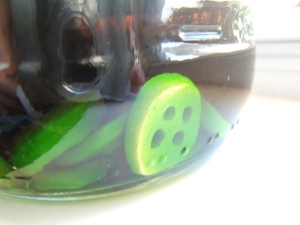Wool-Ease/Acrylic-Sleaze….BAH.
December 29, 2009
Lion Brand Yarn: Wool-Ease, Thick and Quick. You promised me nothing you didn’t deliver. Wool-acrylic blend. Without even bothering to seek out the ratio, I snatched you off the Hancock shelves… but I ought to have known better.
However, I feel as though all my yarn store snobbery has been officially justified.
86% acrylic. 10% wool. 4% rayon.
Never have lamb fleeces been so pointlessly incorporated.
Why even bother listing wool as an ingredient? I suppose my first clue should have been the advert: “machine washable and dryable!” Seriously…Wool-Ease. No shame.
Again, I only blame myself for this pointless foray into the world of dye and acrylic. Never again will I assume that a product has enough wool to hold color merely because that’s what it is named.
Mysteries of the ‘Verse
December 24, 2009
Dying ceramics somehow seperates the pigments.

I used the standard egg-dying process: 2 Tbs. vinegar, 3/4 cup hot water, 2 tsp. food coloring (per jar).

The violet batch. Some red clay was present, and it soaked up all the red pigment, leaving a true blue on the rest. In a few days, the ceramics absorbed it more fully and the pigments faded from the surface a little.
But the question remains:
Why did they seperate in the first place?
Dead Week Kick-Off
December 7, 2009
It’s that time again, folks. Deadweek. The week of test preparations.
Or, if you’re an art student, the week of project deadlines.
If you’re an independent study art student, it’s the week to evaluate how little you’ve accomplished in proportion to your overblown self-expectations.
So this weekend I took a minor road trip to visit Kurt in Oklahoma. It was a belated birthday celebration of sorts involving chess, Mexican food, and Saturday Night Live. Also Hitchhiker’s Guide to the Galaxy. I also brought a blank canvas and my oil paints so I could make him a belated birthday present. So I sat him down in a nice, comfy papazan chair, converted the kitchen trashcan into a makeshift easel, plugged in Afro Samurai, and spent an intense two hours of alla prima oil painting (where you paint everything in one sitting, start to finish).

Yes indeed. Afro Samurai himself, voiced by Samuel L. Jackson. More pressurized blood and deadly stuffed animals than you can shake a stick at. Or a paintbrush, for that better. But fantastically done from an artistic standpoint. 😀
I think my style was slightly influenced. But it might be all in my head.
Just before I hit the road to get there Friday night, we (ceramics class) completed another raku firing. Nothing happened this time…no accidents…no close calls, even. I need to get my adrenaline fix elsewhere, because we’re just getting too good.

At least the holes in the gloves give some sort of excitement. I can remove things until the gloves begin to smoke. The catch is stopping before the flames start.
Here are a few interesting tidbits about raku for those who have little know-how:
(i.e. things I’ve learned in the past month)…
1. Tongs can be used as a stable extension of the kiln handle, so the opener’s arm hair can remain intact.
2. Raku firings need a special team of three: an opener (for the kiln lid), a remover (operating tongs), and a guy-who-throws-on-sawdust-and-shoves-bucket-overtop-and-down-into-the-sand.
3. Just because the glaze doesn’t say “raku” doesn’t mean you can’t try it…if there are metal oxides, it can be reduced.
4. Bandannas keep hair alive and intact.
5. It really is better to do it outside, if at all possible. Some funky fumes happen.
6. All that junk on there afterwards…you can scrub that off.
The buttons on the top row are the “Shake It And Scream” technique taught to me by a good friend. Rapidly cooling the glaze forms major cracks, and smoking it immediately after forces carbon down into the cracks, outlining a spiderweb pattern of black.
The bottom row is the “Reduction” technique, where you place the buttons on the combustibles and seal it as soon as possible, forcing the heat to eat all the oxygen in the air and turn to the glaze, ripping out those oxygens through a chemical process, turning the metal oxides back to their pure metal form. The longer the glaze is exposed to the air, the more the color and less the metallic effect. Any exposed bisque is smoked black.
Also, I tried to burn off strategic areas of carbon off a different pot I had previously smoked (harharhar…yeah…I know…get over it). At first, I figured kerosine and rags would do the trick.

It was buried in the sand to keep the outer shell's temperature cool to keep its carbon on. I didn't need to worry though, because a little fire like this didn't burn hot enough or long enough to make much of a difference.
So…plan #2: de-smoking with a blow-torch.

Despite my efforts to keep the torch moving and the heat consistent, the pot still cracked. It's okay, though, because they fit the piece. Once I figure out how to effectively light and photograph black objects, I'll post a good pic, because it worked in the end. The inside's white, fading to black as it approaches the opening.
Finally, since the pot was still warm from the blow-torch, I waxed the burnished surface. Waxing on a cold surface can produce a white residue after about a week; it’s important to melt it into the surface. Even in his treatises on fresco, Alberti recommends heating a waxed surface. Story old as time, song old as rhyme.




















